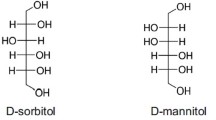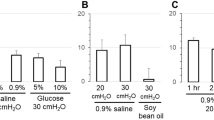Summary
Chloride excretion was studied in control rats, and in rats receiving an infusion of 1 mg/kg x min of Furosemid or 0.1 ml/min of 4% NaCl, through measurement of Cl TF/P concentration ratios in proximal and distal tubular fluid. Fluid reabsorption was evaluated by measurement of inulin TF/P ratios. In proximal tubule, chloride TF/P's were always higher than 1, respectively 1.29 in controls, 1.23 during NaCl infusion, and 1.29 after Furosemid. In distal tubules both control (mean TF/P=0.30) and 4% NaCl infused rats (mean TF/P=0.51) had ratios below unity, whereas Furosemid infused rats showed a value of 1.27, indicating the absence of the normal osmolar gradient in early distal tubule.
Net fluid reabsorption across the proximal tubule showed no significant reduction with Furosemid, and some reduction with 4% NaCl. With Furosemid, however, the transepithelial transport rate as measured with the split-drop method was significantly reduced (t/2=16.3 sec) in comparison with controls. This reduction, however, was offset by increased transit times, measured with Lissamine green, leading to somewhat increased overall reabsorption.
The variation in chloride and inulin concentrations between distal tubule and final urine showed almost complete absence of urinary concentration along the collecting duct in the Furosemid group. These data suggest that this substance may act, under the present experimental conditions, mainly on the ascending limb of Henle's loops, and therefore on the “single effect” of the medullary countercurrent system.
Distal electrical PD measurements did not show any significant change with respect to controls in the Furosemid group, indicating no, alteration of the permeability of the tubular membranes.
Zusammenfassung
Die Chloridausscheidung wurde in Kontrollratten und in solchen mit 1 mg/kg · min Furosemid- oder 0,1 ml/min 4% NaCl-Infusion mittels Bestimmung der proximalen und distalen Cl TF/P Quotienten untersucht. Proximal waren diese Werte durchwegs höher als 1, und zwar 1,29 in Kontrollen, 1,23 während NaCl- und 1,29 bei Furosemidinfusion. Distal fanden sich Werte under 1 bei Kontrollen (0,30) und bei 4% NaCl Infusion (0,51), während Furosemidinfundierte Ratten einen Mittelwert von 1,27 aufwiesen, was auf die Abwesenheit des normalen frühdistalen Osmolaritätsgradienten hinweist.
Die mittels Inulin gemessene Nettowasserresorption wurde im proximalen Tubulus signifikant durch 4% NaCl-Infusion verringert, nicht aber durch Furosemid. Nach Gabe dieses Diureticums wurde eine signifikante Verlängerung der Resorptionshalbwertszeiten im gespaltenen Tropfen (t/2=16,3 sec) beobachtet. Dies wurde jedoch durch erhöhte Farbstoffpassagezeiten kompensiert.
Die geringe Veränderung von Chlorid und Inulinkonzentrationen zwischen distalem Tubulus und Endharn zeigt die beinahe vollkommene Ausschaltung der Harnkonzentrierung längs des Sammelrohres in der Furosemidgruppe. Dieser Befund deutet auf den aufsteigenden Ast der Henleschen Schleife als Angriffspunkt dieses Diureticums, d. h. auf die Ausschaltung des Einzeleffektes des medullären Gegenstromsystems.
Distale transtubuläre Potentialdifferenzen wurden nicht durch Furosemid verändert, was eine Veränderung der Permeabilität dieser Strukturen auszuschließen scheint.
Similar content being viewed by others
Literatur
Brunner, F. P., F. C. Rector, andD. W. Seldin: Mechanism of glomerulotubular balance. II. Regulation of proximal tubular reabsorption by tubular volume, as studied by stopped-flow microperfusion. J. clin. Invest.45, 603–611 (1966).
Buchborn, E., u.S. Anastasakis: Angriffspunkt und Wirkungsmechanismus von Furosemid am distalen Nephron des Menschen. Klin. Wschr.42, 1127–1131 (1964).
Clapp, J. R., F. C. Rector, andD. W. Seldin: Effect of unreabsorbed anions on proximal and distal transtubular potentials in rats. Amer. J. Physiol.202, 781–786 (1962).
Deetjen, P.: Mikropunktionsuntersuchungen zur Wirkung von Furosemid. Pflügers Arch. ges. Physiol.284, 184–190 (1965).
Dirks, J. H., W. J. Cirksena, andR. W. Berliner: Micropuncture study of the effect of various diuretics on sodium reabsorption by the proximal tubules of the dog. J. clin. Invest.45, 1875–1885 (1966).
Gertz, K. H.: Transtubuläre Natriumchloridflüsse und, Permeabilität für Nichtelektrolyte im proximalen und distalen Konvolut der Rattenniere. Pflügers Arch. ges. Physiol.276, 336–356 (1963).
—,J. A. Mangos, G. Braun, andH. D. Pagel: On the glomerular tubular balance in the rat kidney. Pflügers Arch. ges. Physiol.285, 360–372, (1965).
Giebisch, G., R. M. Klose, andE. E. Windhager: Micropuncture study of hypertonic sodium chloride loading in the rat. Amer. J. Physiol.206, 687–693 (1964).
—,G. Malnic, R. M. Klose, andE. E. Windhager: Effect of ionic substitutions on distal potential differences in rat kidney. Amer. J. Physiol.211, 560–568 (1966).
Gottschalk, C. W., andM. Mylle: Micropuncture study of the mammalian urinary concentrating mechanism: evidence for the countercurrent hypothesis. Amer. J. Physiol.196, 927–936 (1959).
Herms, W., u.K. E. Hofmann: Untersuchungen an der Froschhaut zur Kenntnis des Wirkungsmechanismus von Diuretica an transportaktiven Membranen. Naunyn-Schmiedebergs Arch. exp. Path. Pharmak.251, 355–374 (1965).
Hierholzer, K., M. Wiederholt, u.H. Stolte: Der Einfluß hypertoner NaCl-Infusionen auf die renale Na-Resorption intakter und adrenalektomierter Ratten. Pflügers Arch. ges. Physiol.283, R 71–72 (1965).
Hilger, H. H., J. D. Kluemper, u.K. J. Ullrich: Wasserrückresorption und Ionentransport durch die Sammelrohrzellen der Säugetierniere. Pflügers Arch. ges. Physiol.267, 218–237 (1958).
Holzgreve, H., A. Frick, G. Rumrich, K. Wiederholt u.K. J. Ullrich: Wirkungsweise von Diuretika auf den transtubulären Transport von Natriumchlorid. 3. Symposion der Ges. für Nephrologie 147–154 (1964).
Hook, J. B., andH. E. Williamson: Effect of furosemide on renal medullary sodium gradient. Proc. Soc. exp. Biol. (N.Y.)118, 372–374 (1964).
Kashgarian, M., H. Stoeckle, C. W. Gottschalk, andK. J. Ullrich: Transtubular electrochemical potentials of sodium and chloride in proximal and distal renal tubules of rats during antidiuresis and water diuresis (Diabetes insipidus). Pflügers Arch. ges. Physiol.227, 89–106 (1963).
Kuhn, W., u.A. Ramel: Aktiver Salztransport als möglicher (und wahrscheinlicher) Einzeleffekt bei der Harnkonzentrierung in der Niere. Helv. chim. Acta42, 628–660 (1959).
Lassiter, W. E., M. Mylle, andC. W. Gottschalk: Net transtubular movement of water and urea in saline diuresis. Amer. J. Physiol.206, 669–673 (1964).
Litchfield, J. B., andP. A. Bott: Micropuncture study of renal excretion of water, K, Na and Cl in the rat. Amer. J. Physiol.203, 667–670 (1962).
Malnic, G., R. M. Klose, andG. Giebisch: Micropuncture study of renal potassium excretion in the rat. Amer. J. Physiol.206, 674–686 (1964).
———: Micropuncture study of distal tubular potassium and sodium transport in rat nephron. Amer. J. Physiol.211, 529–547 (1966).
Muschaweck, R., u.P. Hajdú: Die salidiuretische Wirksamkeit der Chlor-N-(2-furylmethyl)-5-sulfamyl-Anthranylsäure. Arzneimittel-Forsch.14, 44–47 (1964).
Nagel, W., u.W. Karger: Die Wirkung von 4-Chloro-N-(2-Furylmethyl-5-sulfamyl-Anthranylsäure (Lasix®) auf ionenaktive Membranen. Pflügers Arch. ges. Physiol.281, R 63 (1964).
Ramsay, J. A., R. H. J. Brown, andP. C. Croghan: Electrometric titration of chloride in small volumes. J. exp. Biol.32, 822–829 (1955).
Seldin, D. W., G. Eknoyan, W. Suki, andF. C. Rector: The physiology of modern diuretics. III Int. Congr. Nephrology, Washington, Abstracts I, 77–78 (1966).
Steinhausen, M.: Eine Methode zur Differenzierung proximaler und distaler Tubuli der Nierenrinde von Ratten in vivo und ihre Anwendung zur Bestimmung tubulärer Strömungsgeschwindigkeiten. Pflügers Arch. ges. Physiol.277, 23–35 (1963).
Strickler, J. C., D. D. Thompson, R. M. Klose, andG. Giebisch: Micropuncture study of inorganic phosphate excretion in the rat. J. clin. Invest.43, 1596–1607 (1964).
Suki, W., F. C. Rector, andD. W. Seldin: The site of action of Furosemide and other sulfonamide, diuretics in the dog. J. clin. Invest.44, 1458–1469 (1965).
Walker, A. M., P. A. Bott, J. Oliver, andM. C. Mac Dowell: The collection and analysis of fluid from single nephrons of the mammalian kidney. Amer. J. Physiol.134, 580–595 (1941).
—,C. L. Hudson, T. Findley andA. N. Richards: The total molecular concentration of fluid from different segments of the renal tubule of amphibia. Amer. J. Physiol.118, 121–129 (1937).
Windhager, E. E., andG. Giebisch: Micropuncture study of renal tubular transfer of sodium chloride in the rat. Amer. J. Physiol.200, 581–590 (1961).
Author information
Authors and Affiliations
Additional information
Diese Arbeit wurde mit Unterstützung der Fundação de Amparo à Pesquisa do ESP durchgeführt.
Ein vorläufiger Bericht ist in Nature208, 80 (1965) erschienen.
Rights and permissions
About this article
Cite this article
Malnic, G., Enokibara, H., Aires, M.M. et al. Die Wirkung von Furosemid und NaCl-Belastung auf die Chloridausscheidung im Einzelnephron der Rattenniere. Pflugers Arch. 309, 21–37 (1969). https://doi.org/10.1007/BF00592279
Received:
Issue Date:
DOI: https://doi.org/10.1007/BF00592279




